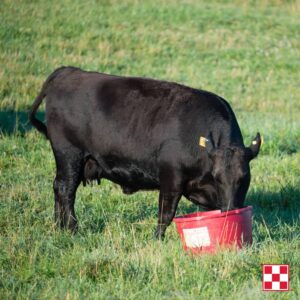Why Are Protein and Fat Critical to Cattle Nutrition?
 Protein is a vital nutrient for maintenance, growth, health, reproduction and lactation in cattle. Protein supplies the microbes in the gut, or rumen bugs, the ammonia and nitrogen sources they need to function. These microbes ferment feed to make Volatile Fatty Acids (VFAs) and Microbial Cell Protein (MCP), which are responsible for digestion.
Protein is a vital nutrient for maintenance, growth, health, reproduction and lactation in cattle. Protein supplies the microbes in the gut, or rumen bugs, the ammonia and nitrogen sources they need to function. These microbes ferment feed to make Volatile Fatty Acids (VFAs) and Microbial Cell Protein (MCP), which are responsible for digestion.
When cattle aren’t getting enough protein, microbial activity decreases, causing a lower rate of digestion. Decreased digestion results in less nutrition available for absorption by the animal. While these effects are internal, you would observe the consequences of protein deficiency in the growth of your cattle.
Fat supports cow body condition and reproduction. Research suggests that the addition of limited fat supplements to beef cattle diets before breeding enhances reproduction by reducing the anestrus period after calving, as well as increasing the number of follicles formed on the ovary of the cow.1
How much is needed? Like with most cattle questions, it depends.
With protein, anything less than 8% crude protein in your forages is not enough to feed the rumen microbes for optimal performance. When forage quantity and quality begin to decline, you should start thinking about supplementation to bridge that gap. The amount of supplemental energy or fat provided will depend on current body condition, other feed resources available and target production goals for that animal or herd.
There are several factors to consider when determining the supplemental nutrition needs of your cattle:
Forage quality & quantity: As pastures move from a vegetative state to a reproductive or dormant state, the nutritional value decreases. Vegetative forage will provide the most protein (10-18%), transitional forage will provide 6-9% crude protein and dormant forage will provide the poorest quality nutrition with typically less than 5% crude protein. Protein supplementation can help support rumen bug population and forage utilization in these transitional periods.
Body Condition Score (BCS) and Production Phase: BCS can indicate how your nutrition program is working. You don’t want to wait until your herd’s average BCS drops and have to play catch up, especially in key production phases like breeding, late gestation and lactation. Consistent monitoring can tell you when supplementation is needed.
Age: Younger, developing cattle that are still growing will have a higher maintenance requirement than mature cattle.
 The goal of any protein and fat supplement like Purina® Accuration® Hi-Fat blocks and RangeLand® tubs is to support the returns of producers by enhancing forage intake and supporting better utilization of forages to meet needs of cows. Products like these are great options for protein and fat supplementation for your herd because they are designed to enhance the use of forages, not replace them.
The goal of any protein and fat supplement like Purina® Accuration® Hi-Fat blocks and RangeLand® tubs is to support the returns of producers by enhancing forage intake and supporting better utilization of forages to meet needs of cows. Products like these are great options for protein and fat supplementation for your herd because they are designed to enhance the use of forages, not replace them.
